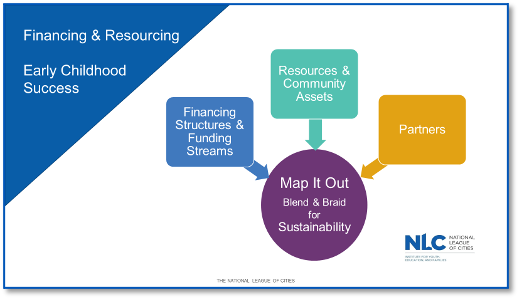Many city leaders across the country are champions for early childhood success. As city leaders, they are also charged with balancing and budgeting the city’s many responsibilities for the physical infrastructure, human infrastructure, and core services. Just like our own family budgeting, municipal budgeting has to prioritize musts (essential services), wants (enhancements), and the unforeseen (emergency funds) to decide where to spend and focus attention.
Commonly, existing investments and revenues fall short and may not cover services for all the children and families who need them nor allow for testing and implementing innovative approaches for improvement. Recently, local leaders shared their strategies in NLC’s Early Childhood Municipal Policy series. Highlights from the series include the need for a community-wide approach and the critical role of municipal government. No one government, parent, business sector, school, or organization can fund and resource early childhood success independently. What stood out is the importance of coordination, intention, and partnerships, along with the necessity to blend and braid financing and resourcing for sustainability.

The conversation began with a broad look at the State of the Cities, noting common municipal priorities and challenges, along with Cities Fiscal Conditions, highlighting the financial impacts of the recession and pandemic, with early information on municipal recovery efforts and how cities are planning and taking action. With specific focus on funding early childhood success, Elizabeth Gaines, founder of Children’s Funding Project, noted four steps municipal leaders can take: Find out what funding streams and resources are available; Align for efficiency and effectiveness; Generate innovative ways to use current and new resources; Activate your strategy and monitor impact.
Three cities shared their innovative approaches and how they are looking at recovery. Las Vegas, Nevada, leveraged existing city assets. Las Vegas redeveloped unused space within city-owned buildings for child care and Pre-K facilities. The three buildings are contracted out to providers at reduced market-rate rent, with the city providing all maintenance services, with the requirement that subsidized care is provided to qualifying families. A fourth facility is currently underway to co-locate health and child care near housing. Las Vegas’ Strong Start Early Learning Academies also includes two mobile Pre-K units.
Two cities from Nebraska demonstrated that innovation happens in cities of all sizes. Both the City of Gothenburg and the City of Wood River have populations under 5,000. With the need for child care being an economic imperative, they each set out to build facilities to increase access to child care in their community. They each worked with existing local child care providers and included multi-sector partners. The Gothenburg Early Childhood Learning Coalition set out planning and fundraising for a new multi-purpose Impact Center that would include child care. This community center will be partly owned by the city and both the city and school district will contribute to the operating budget. The two existing child care centers will merge together to provide expanded services in the new space. Excess revenue from events will be used to support the cost of high-quality care.
The Wood River Vision 20/20 task force is “connecting ideas and resources to make Wood River an even better place to live…” And that is what they did in opening Stick Creek Kids Child Development Center. With the support and leadership of Mayor Greg Cramer, the city was able to purchase an empty nursing home at a deep discount. Leveraging community and corporate donations, Community Development Block Grant funding, a Rural Economic Development Loan & Grant from USDA, USDA Communities facilities grant, and EPA funding for environmental remediation, the building was renovated, opened May 3rd, and is thriving. They are building an endowment with the intent of using the earning for scholarships.
Key Takeaways
- City leaders are charged with balancing and budgeting the city’s responsibility for the physical infrastructure, human infrastructure, and core services. Consider what resources are available within and outside city government.
- Blend and braid funding, resources, and community assets and partnerships for sustainability.
- “Find – Align – Generate – Activate” your financing and resourcing plan for early childhood success.
- Never underestimate the power of partnerships.
Communities continue to look for and are finding ways to finance and resource prenatal to age 8 services and programs, with more approaches being implemented each year. With local governments having a real impact on the prosperity of young children and families, cities across the country are investing in early childhood as an investment in today and our future.
Take Action: Map out your community’s financing and resourcing plan for early childhood success by understanding funding streams and financing structures, take note of your community assets and resources, and work in partnership as you blend and braid for sustainability.
Learn More
NLC’s Early Childhood Municipal Policy 101 series:
- Embedding Equity into How Your City Does Business
- Navigating the Political Landscape for Early Childhood Success
- Aligning City, County, and State for Early Childhood Success
- Financing and Resourcing Early Childhood Success
DISCLAIMER: The information contained here is not legal advice. It will be subject to change based on updates from the U.S. Department of the Treasury, and any recipients should confirm applicability to their specific situation.









